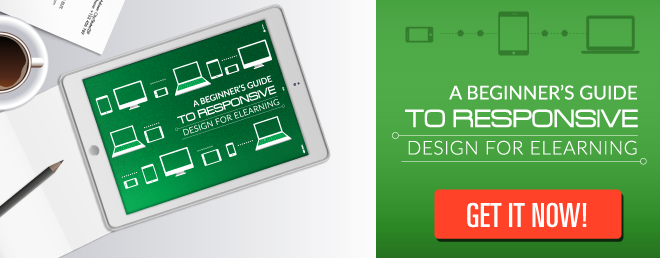Mobile platforms are no longer the future; it’s where we’re at today. Our on-the-go culture isn’t slowing down. Whether learners are waiting for their lunch in a line at the deli or for an appointment at the doctor’s office, they want the most up-to-date information readily available across all different platforms but, most particularly, on their smartphones and tablets. Your employees expect their workday to be as mobile as their lifestyle.
Developing a mobile learning strategy will be imperative to have more engaged, efficient, and connected employees in 2022 and beyond. Creating mobile courses for workers to turn to any time, anywhere, will guarantee your training is part of the movement.
The purpose of this blog post is to help you develop a framework on how to start implementing a mobile learning strategy for your company or your client's company.
Take note! The ingredients and mindset to design a mobile course are VERY different (check out the differences here). It’s all about getting your toes in the mobile learning waters and start experimenting. Once you identify what works, scaling up will be a given.
1) Getting Acquainted with WHO
The most important part of creating a course is determining WHO will be consuming it.
Some essentials to consider are:
- Do they work in offices or do they engage in physical labor outdoors? — This defines the level of mobility your course content should offer. For example, outdoor workers will benefit from a course that has less reading content and audio, video, and visual content (info graphs, etc.)
- Do they travel a lot? Employees who often travel for business could benefit from accessing training courses on airplanes or other offline environments. This could drive you to consider a native mobile application that users can download to their phones — as opposed to the traditional responsive course that requires a constant Internet connection.
- What is their level of education? Are they tech-savvy?
- What software and programs do they use in their daily work? — Let’s supplement the course with already available courses.
- Will your audience benefit from taking the course? Getting to know their goals and expectations in taking the course is very important.
- Why are they accessing your course? What skills are they looking to acquire? Are they interested in taking the course? If you discover they are not, you have to think about how to engage them.
Also read: These 27 Questions Will Help You (Really) Know Your Learners
2)Getting Acquainted with “When”
Since you will be creating courses to be accessible on any device learners use, considering phone usage patterns will be important, too. Understanding WHEN your learners are turning to their phones will prove extremely useful in making the learning experience valuable.
Dr. Conrad Gottfredson and Bob Mosher’s Five Distinct Moments of Need have best identified when learning is sought out.
According to them, these Five Moments of Need motivate learners:
- When they are learning an aspect for the first time (New)
- When they want to deep-dive into a topic (More)
- When they want to apply or remember something (Apply)
- When they need to solve a problem or fix something that has gone wrong (Solve).
- When something changes (Change)
Taking advantage of these moments will enhance your mobile training programs, and you’ll be able to reach your employees where they are most comfortable: through the devices, they’re taking on the go. Identifying them for every learning outcome allows us to create opportunities for engagement round the clock.
Also read: Start Thinking of Micro Learning Moments Now
3) From The Monitor To Your Phone Screen
The first thing to know when creating a mobile learning course is that your current pc-only content will not be as effective on a mobile platform. Without an abundance of time and limited to a smaller screen, you'll be required to break down information from blocks of text to digestible bullets, highlighting key ideas and simplifying modules. Additionally:
- Graphics: Media should be minimized considering that the view of the course will depend on how the learner will be using their phone (vertical or horizontal). Also, given limited space on the phone, it’s important to not incorporate bulky images or graphics to avoid slowing learners down. * Videos are highly effective for mobile. Read: Why Video is a Must-Have for Your Mobile Learning Strategy
- Content: For your mobile program to succeed, it is necessary to get quality content that takes advantage of the capacities of mobile devices. Don't just dump your existing content, adapt it to the new medium.
- Distractions: One of the most obvious things to remember during mobile adaptation is the learner will be on their phone, dipping in and out between activities. Therefore, you’ll want to keep the distractions in mind and make it easier for students to pick up where they left off. Make sure that content for mobile is bite-sized (10-15 minutes max). Learners won’t be jumping on their phones for 30-minute online learning modules.
- Navigation: This will be one of the most (or least) frustrating points for the learner’s experience as you will be able to influence how easy it will be for them to move around your course. As mentioned above, if learners are logging on and off constantly, this will be a constant interaction that you’ll want to get down.
- Tracking: SCORM (Sharable Content Object Reference Model) and xAPI, will help you stay informed on what is working on your site and what needs to be adjusted. Looking into learner’s behaviors can indicate lowering or increasing the difficulty of the course, or providing additional content for further reading.
Also read:
4 Signs That Your Company Needs to Implement a Learning Record Store (LRS)
Why Reading on Mobile is Different (And What Course Designers Can Do About It)
4) Behind the Scenes: Planning for a Responsive Course
Choosing the right authoring tool will be extremely important to the success of your mobile program. Two key points will be selecting a responsive authoring tool that 1) supports HTML5 and 2) simplifies the overwhelming technical stuff. For instance, choose a tool in which you just have to create a course once, and it will automatically display on any device seamlessly. It’s imperative to protect the user’s experience with your course! Learners use a variety of devices during their day, and they want your course to work on all of them.
In addition to selecting the right authoring tool, below are some more factors that can value your decision-making:
- Will your company provide devices or require a BYOD (bring your own device) policy?
- Will your instructors be familiar with selected devices?
- What do we really mean when we say “mobile”? This term is used loosely to refer to various technologies (smartphones, tablets, minis, smartwatches). Be specific about the devices your audience will be using.
Additional questions regarding, devices will include:
- Do you have a solid infrastructure? For new tools to be useful, strategy to succeed, and the content to flow right, infrastructure must be in place to carry the entirety of the course you are offering.
- Also, if students are going to be using the Internet, in order to take a course that relies on cloud services, you should count on an Internet connection that is fast enough, with Wi-Fi or 3G/4G coverage.
Also read:
Why Responsive eLearning is Essential to Meet Modern Learner Needs
Four Ways to Create an Effective mLearning Strategy
A Comprehensive Guide to Mobile Learning Design



